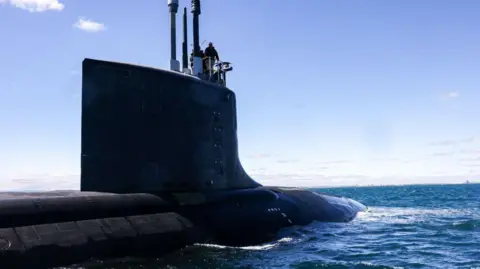What is Aukus, the submarine deal between Australia, the UK and US?
 Getty Images
Getty ImagesA multi-billion dollar submarine deal between long-standing allies - Australia, the UK and the US - has come under the spotlight after the Trump administration said it was reviewing how the deal fits in with its heavily-touted "America First" agenda.
The Aukus security pact, Australia's biggest ever defence project, is set to play a key part in the country's ability to replace its ageing Collins-class submarine fleet - and, crucially, its military standing in the region.
The 30-day review will be led by Elbridge Colby, who has previously been critical of Aukus. In a speech last year, he questioned why the US would give away "this crown jewel asset when we most need it".
A US defence spokesperson said the review is about ensuring "this initiative of the previous administration is aligned with the President's America First agenda".
Fears the review may torpedo the deal have been downplayed by the UK and Australia, with both saying the review is a normal process when a new government takes power.
What is Aukus?
Billed as a trilateral security partnership, the Aukus deal - worth £176bn ($239bn; A$368bn) over 30 years - involves two so-called pillars.
Pillar 1 is about the supply and delivery of nuclear-powered attack submarines.
Australia will buy three second-hand Virginia-class submarines from the US from 2032 with options to purchase two more.
After that, the plan is to design and build an entirely new nuclear-powered submarine model for the UK and Australian navies.
This attack craft will be built in Britain and Australia to a British design, but use technology from all three countries.
Pillar 2 is about the allies collaborating on their "advanced capabilities". This involves sharing military expertise in areas such as long-range hypersonic missiles, undersea robotics and AI.
What's the purpose of the deal?
At its core, the deal is believed to be about countering China's growing presence in the Indo-Pacific region, and its role in rising tensions in disputed territories such as the South China Sea.
While none of the allies have directly pointed at China as a reason for the deal, the three countries have spoken about how regional security concerns have "grown significantly" in recent years.
China condemned the agreement as "extremely irresponsible" when it was first announced.
Foreign ministry spokesman Zhao Lijian said it "seriously undermines regional peace and stability and intensifies the arms race".
Who negotiated it?
The deal was unveiled in September 2021 by three former leaders: Australia's Scott Morrison, the UK's Boris Johnson and the US's Joe Biden.
The UK reviewed the security pact last year after Sir Keir Starmer's Labour government won the general election.
What does Australia get out of it?
For Australia, the deal represents a major upgrade to its military capabilities. The country is set to become just the second to receive Washington's elite nuclear propulsion technology, after the UK.
Such submarines will be able to operate further and faster than the country's existing diesel-engine fleet. They would also mean Australia would be able to carry out long-range strikes against enemies for the first time.
Under the deal, sailors from the Royal Australian Navy are due to be sent to US and UK submarine bases to learn how to use the nuclear-powered submarines.
What do the UK and US get out of it?
From 2027, the pact will allow both the US and UK to base a small number of nuclear submarines in Perth, Western Australia.
It will also create about 7,000 jobs in Britain, with the design and construction of the new fleet of nuclear-powered submarines set to take place in the UK.
The benefits for the US are less obvious - but sharing its defence technology could give the nation an opportunity to grow its presence in Asia-Pacific.
Arming Australia has historically been viewed by Washington and Downing Street as essential to preserving peace in a region that is far from their own.
